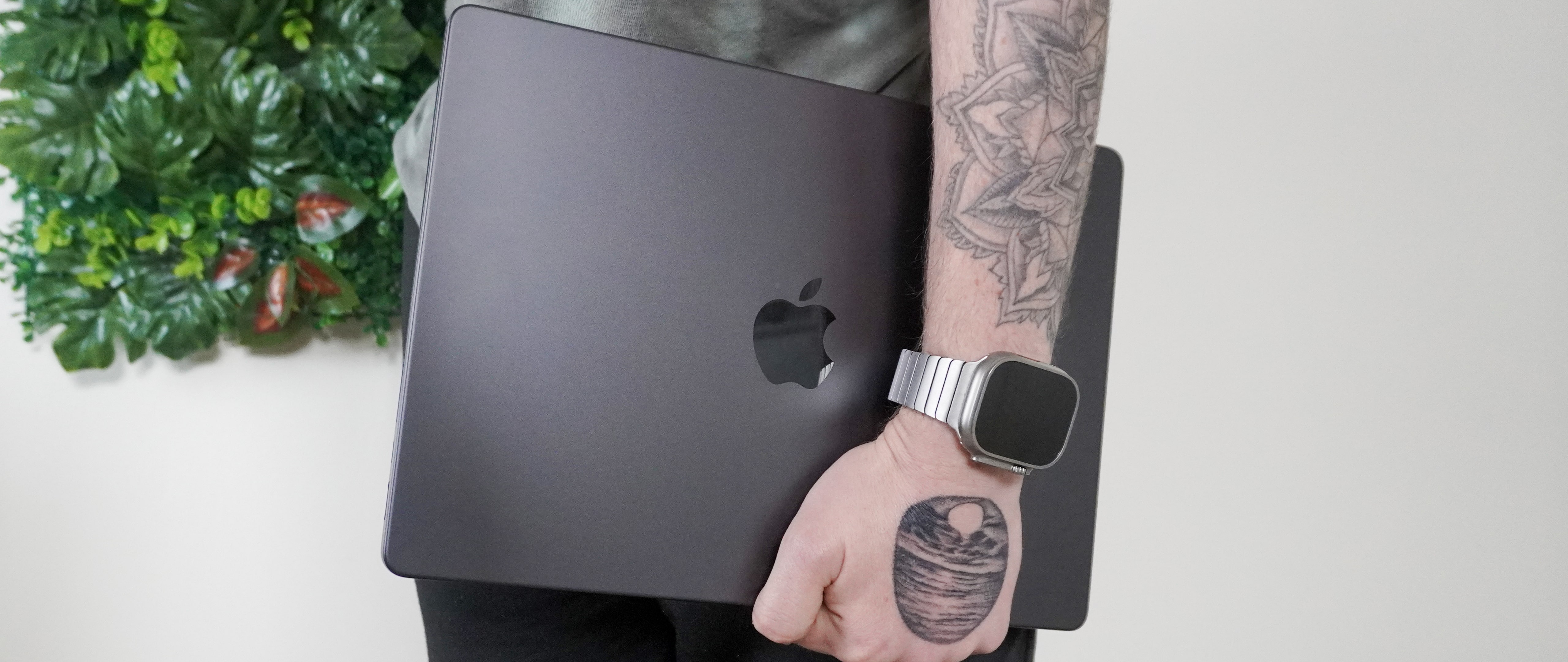Tom's Guide Verdict
The M3 Pro MacBook Pro is a great laptop for all intents and purposes — the M3 Pro is blazingly fast (especially in graphics), battery life is astounding, and you’re getting a better display alongside those stellar speakers in a rock solid aluminum design. But in the face of a new, lower cost 14-inch Pro with M3, it’s hard to justify who will actually benefit from this middle-of-the-road option in the face of saving $400.
Pros
- +
Brighter display with great color accuracy
- +
Impressive M3 Pro power
- +
Dramatically better graphics
- +
Impressive battery life
- +
Still the best speakers in a laptop
Cons
- -
Expensive
- -
Configuration prices are steep
- -
Anti-fingerprint coating not very effective
- -
Who is this for?
Why you can trust Tom's Guide
When it comes to the new generation of MacBook Pros, you’d be forgiven for forgetting this option. Apple has gone hard on telling us all about the new 14-inch Pro with the entry-level M3, and the M3 Max 16-inch monster that makes no compromise to its face-melting performance.
Let’s take a closer look at the middle child — the M3 Pro MacBook Pro. In the past, this family tree wasn’t so awkward. You either got the barebones 13-inch Pro with its TouchBar and lack of ports, or you paid the extra few hundred bucks and got an actual prosumer machine. Now that the smaller Pro has been discontinued, choosing the best MacBook for you just got a whole lot more complicated.
So this is what I’ll focus on here. As you’d expect, this is a stellar laptop with a gorgeously premium design, vividly accurate display, impressive power in M3 Pro and beefy battery life. But is it really worth spending the extra $400 to get this machine over the new lower cost 14-inch Pro with M3? Or is this entry easy to ignore?
M3 Pro MacBook Pro: Specs
| Header Cell - Column 0 | Base model 14-inch MacBook Pro (M3 Pro) |
|---|---|
| Price | $1,999 |
| Display | 14.2-inch (3024 x 1964) Micro LED |
| CPU | Apple M3 Pro (11-core CPU) |
| GPU | Apple M3 Pro (14-core GPU) |
| RAM | 18GB |
| Storage | 512GB SSD |
| Ports | 3x Thunderbolt 4/USB-4, SDXC card slot, HDMI 2.1, MagSafe 3, 3.5mm audio jack |
| Battery life | 17:22 |
| Dimensions | 12.3 x 8.7 x 0.6 inches |
| Weight | 3.5 pounds |
M3 Pro MacBook Pro: Price and configurations
- $2,000 starting price is a tough pill to swallow
- Configuration update costs are like swallowing a brick
Quick first things out of the way, we tested the base model M3 Pro MacBook Pro, which comes in at $1,999 (£2,099). This gives you an M3 Pro chipset, 18GB unified memory (translation: RAM), and a 512GB SSD.
If you want to improve that M3 Pro by bumping up the CPU and GPU cores, that’ll cost you an additional $200, doubling to 36GB RAM sets you back an additional $400, and growing the storage to 1TB is $200.
Of course, you could go further, and spend nearly four grand on this machine with 4TB of storage, but you shouldn’t because that’s a bonkers price to pay, when you could reconfigure and get the M3 Max with decent specs at the same cost.
M3 Pro MacBook Pro: Design
- Back in black, and so much better for it
- Same great utilitarian design as previous models
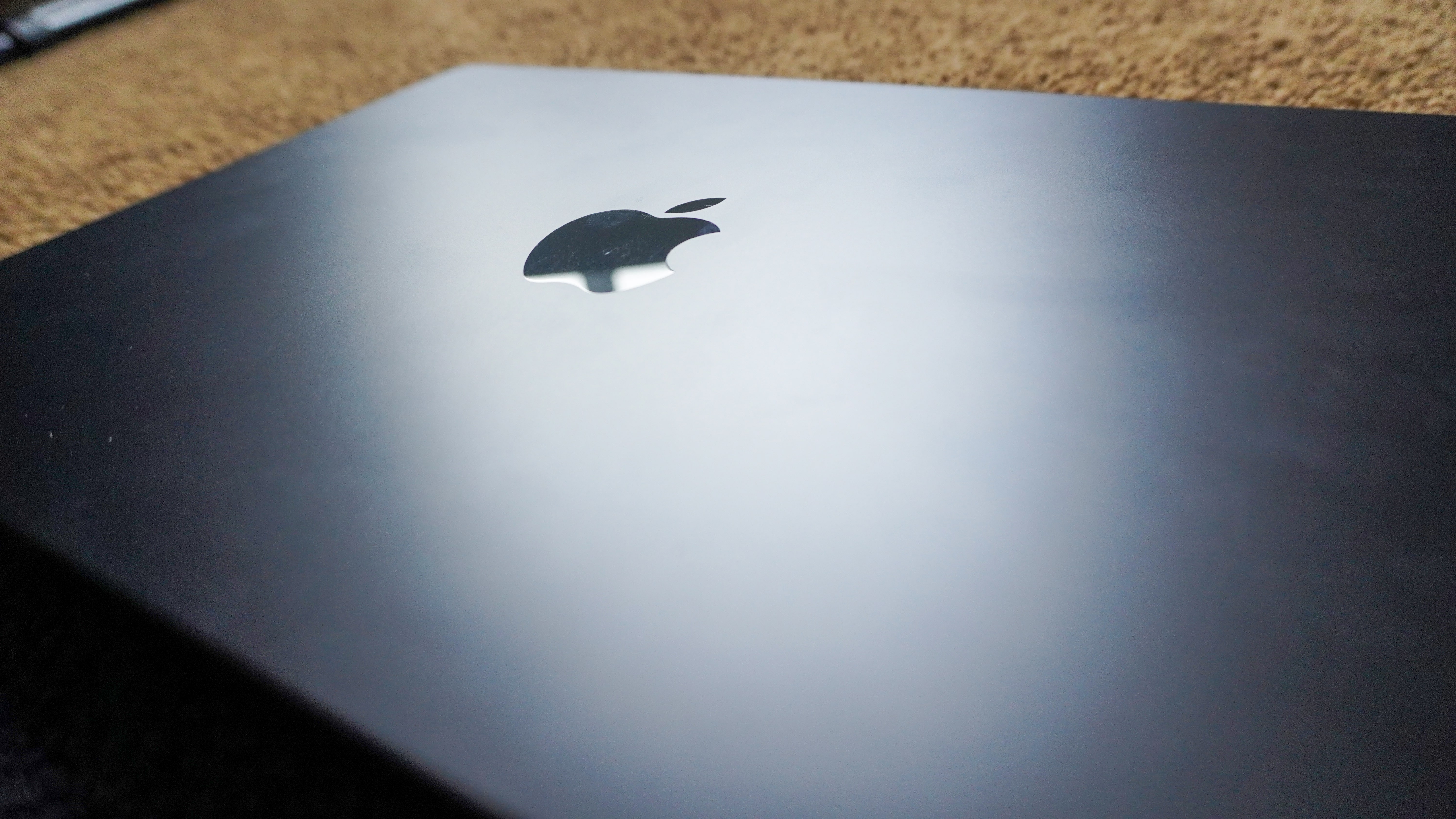
We all know Apple’s song and dance by now — with each redesign comes several years of sticking rigidly to it. In the case of the TouchBar Macs, that was a bad thing, but for the 14-inch Pro shell, it most certainly isn’t.
This premium construction of 100% recycled aluminum and class (adding to a total of 32% recycled content in the device) looks just as mean, lean and ready to rip through your tasks with ruthless efficiency as before. The squared-off chassis provides a confidence in its durability and exudes luxury with its all-metal construction, which is highlighted even further with this new Space Black colorway.
Well, Apple says black — it’s more of a darker Space Grey, but the end result looks like the kinda MacBook Pro you’d see Bruce Wayne edit a RAW photo of Batman on (you know, for the ‘gram…or whatever it’s called in Gotham City). Put simply, I love the new finish, but that much-touted anti-fingerprint seal isn’t as “anti-fingerprint” as you may expect. After a while, you will see those telltale marks of use again, but that’s par for the course with Apple systems.
Dimensions haven’t changed one iota from last year.
| Laptop | Size | Weight |
|---|---|---|
| MacBook Pro 14-inch (M3 Pro) | 12.3 x 8.7 x 0.6 inches | 3.5 pounds |
| MacBook Pro 14-inch (M3) | 12.3 x 8.7 x 0.6 inches | 3.4 pounds |
| MacBook Pro 16-inch (M3 Max) | 14 x 9.8 x 0.7 inches | 4.8 pounds |
That means in the M3 Pro MacBook Pro, you’re getting something that may be a little heavy when compared to the likes of the M2 MacBook Air, but is still a seriously portable machine.
M3 Pro MacBook Pro: Display and audio
- Liquid Retina XDR display continues to shine as a fantastic screen
- Still the best speakers ever put in a laptop
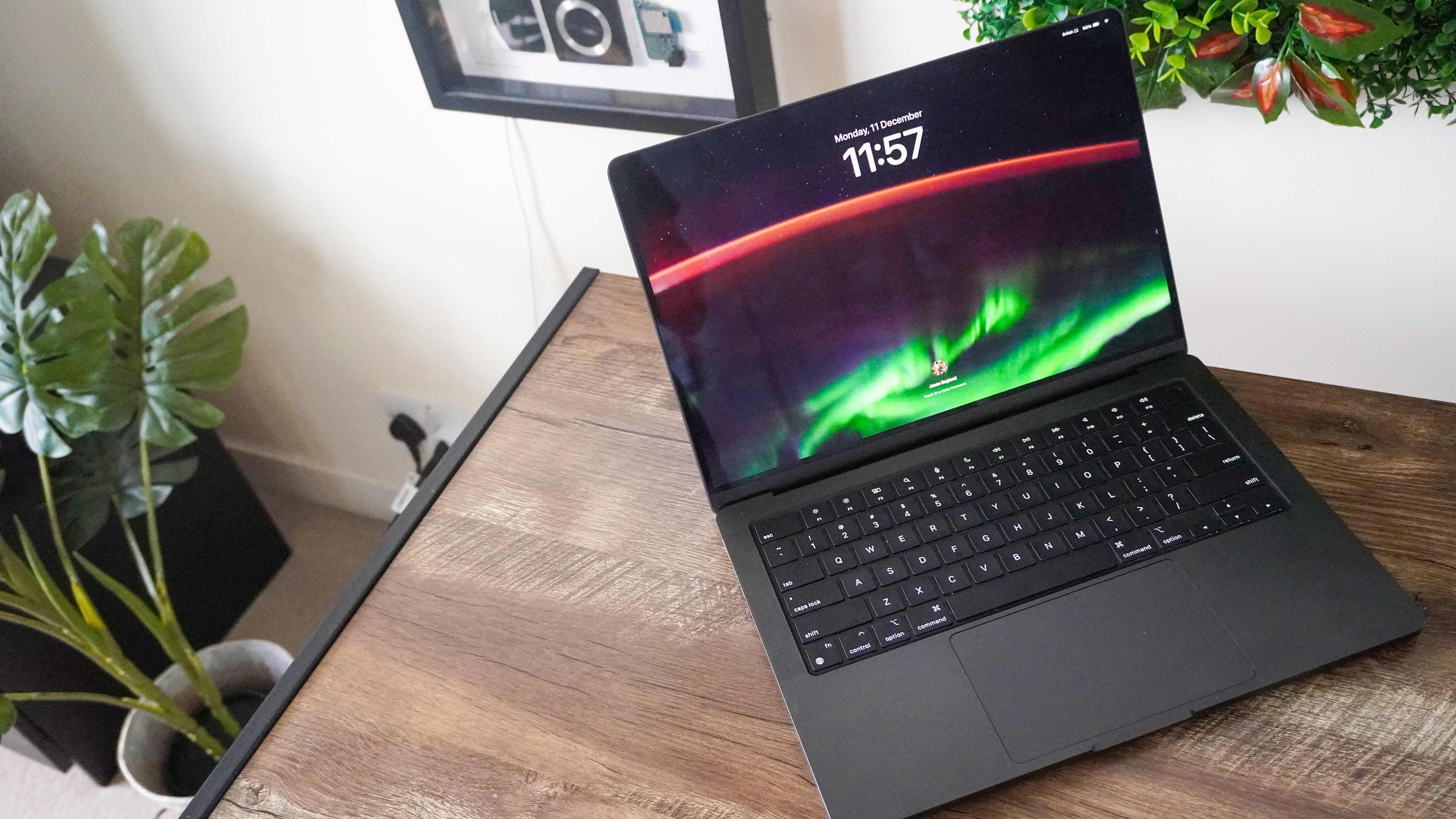
Identical to the lower cost 14-inch Pro, this machine packs the same gorgeous mini-LED Liquid Retina XDR display. Brightness has been boosted over previous Pro models, and even though it’s not OLED, you’re still getting a relatively impressive level of vividity and color accuracy.
Of course, the panels across the same generation of MacBook Pro will vary because of minute changes in environmental circumstances during manufacturing, but to the naked eye, you won’t notice these differences.
| Laptop | Display average brightness (nits) | sRGB color gamut (%) | Delta-E color accuracy (smaller number is better) |
|---|---|---|---|
| MacBook Pro 14-inch (M3 Pro) | 559.8 | 111.60% | 0.29 |
| MacBook Pro 14-inch (M3) | 555.8 | 114.50% | 0.11 |
| MacBook Pro 16-inch (M3 Max) | 563.4 | 116.70% | 0.11 |
Of course, these numbers tell the SDR side of the story. When moving over to HDR, these numbers will increase all the way up to 1,588 nits — that’s “eyes melting in Indiana Jones” levels of backlighting! The difference is stark when a HDR video plays in a YouTube window, as you see it shine so brightly compared to the relatively dull UI of the website. Pro tip: if you want to get this level of brightness across your whole screen, download Vivid.
As for the speakers, nothing has changed over previous generations of MacBook Pro, and they continue to produce the best sound I’ve ever heard out of a laptop. The six-speaker setup with force-canceling woofers is capable of filling a room with its high volume, while producing an impressive level of bass that compliments the mids and highs with no distortion whatsoever.
Whether you’re thrashing the latest Sleep Token album like the angsty metalhead you are (guilty), or enjoying the finer details of a song like 2009 by Mac Miller (also guilty), the definition and presence will floor you.
M3 Pro MacBook Pro: Ports
- Just the right number of ports
- Up to 8K resolution support on external monitors
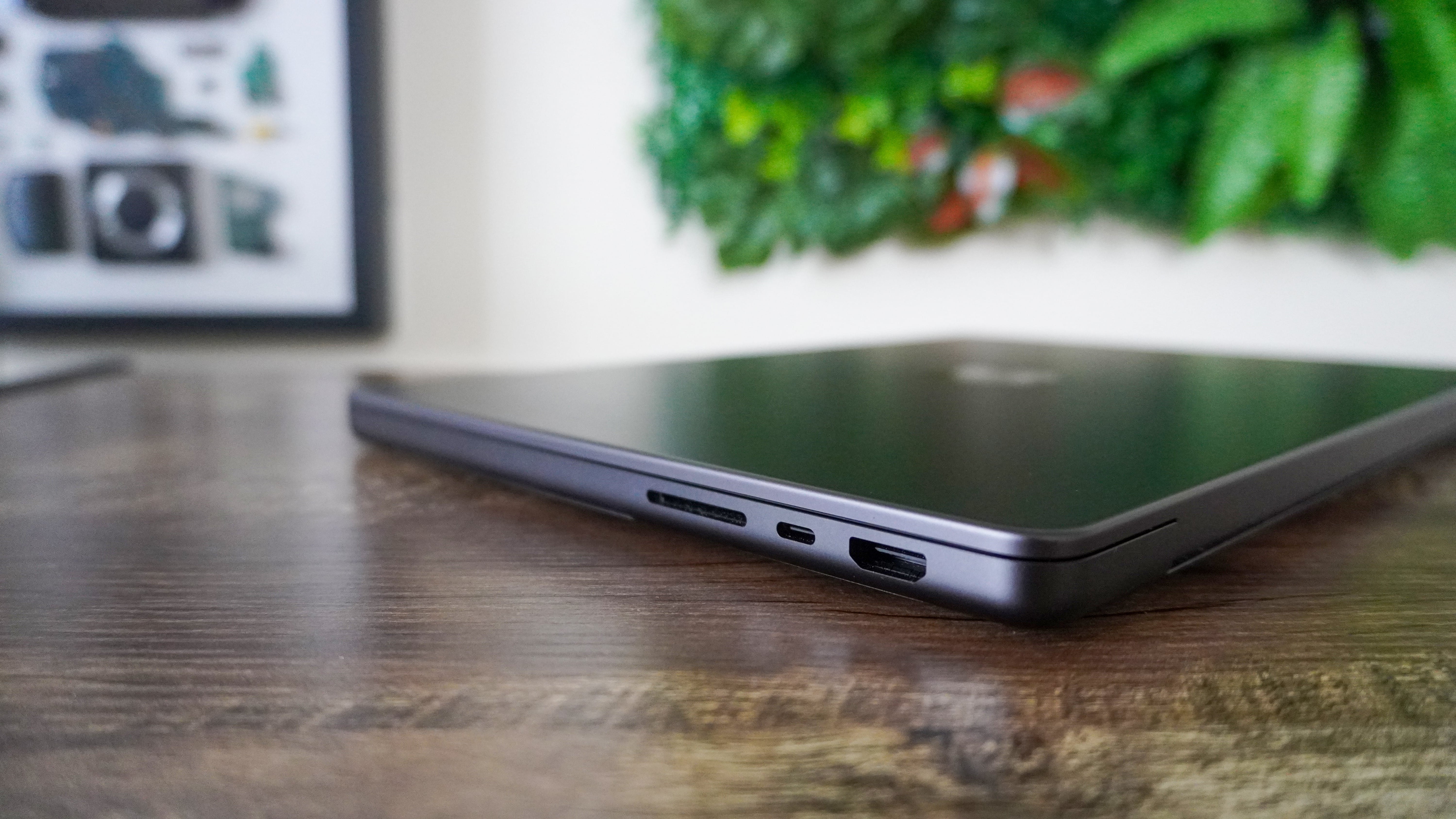
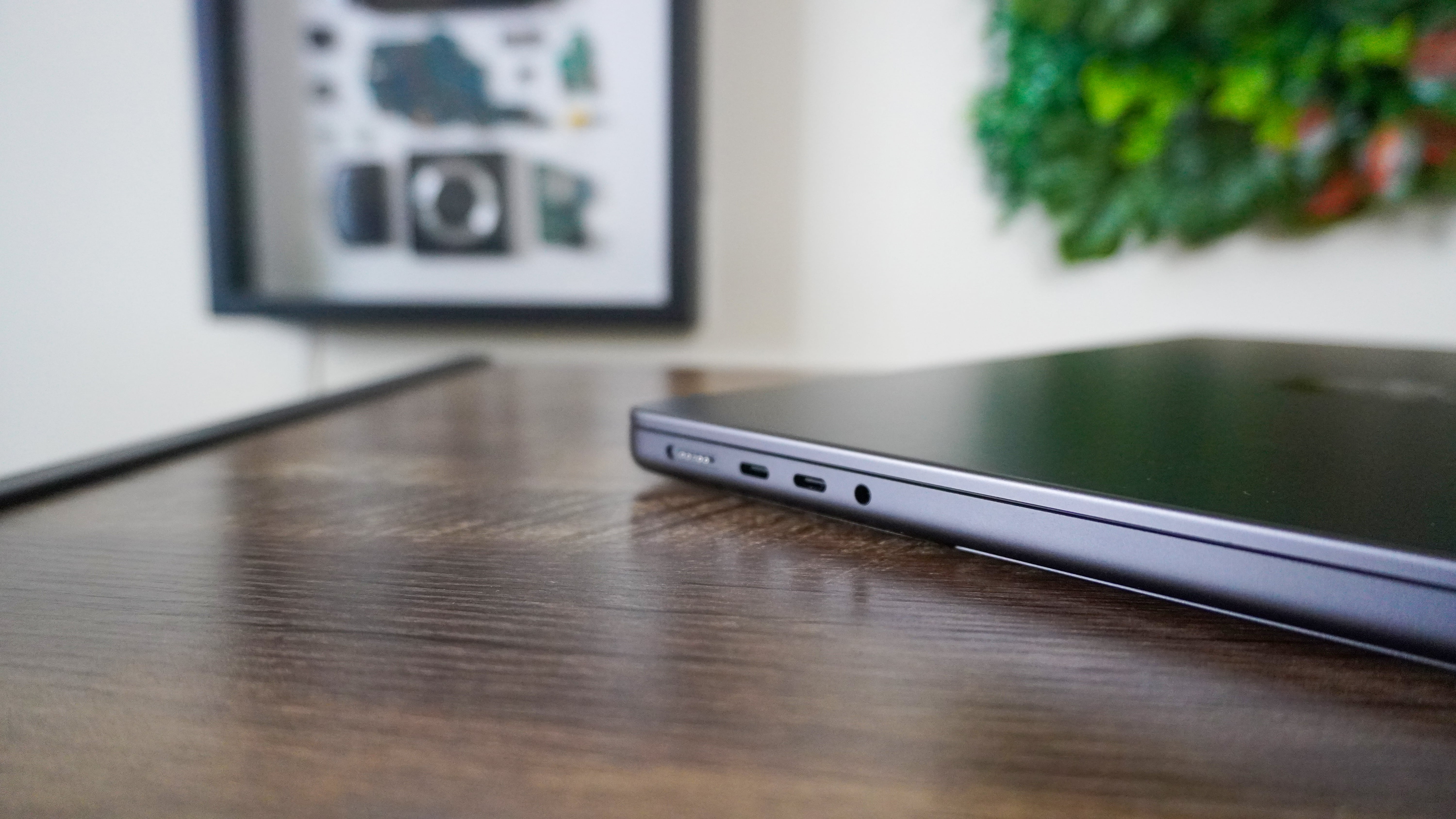
Same as previous 14-inch MacBook Pros, you’ll find three Thunderbolt 4/USB-C ports, a HDMI 2.1 port, a full-size SD card slot, 3.5mm audio jack, and the MagSafe connector for charging.
The main limitation on M3 Pro vs M3 Max when it comes to connectivity is that the Pro can only support two external displays, whereas the Max can run four. You’re still getting that 8K 60Hz for one monitor if you have an external screen that beasty.
Should Apple include a USB-A port? Sure. Will they? No. I won’t spend my time having a bit of a rant about this on here, as this legacy port is slowly but surely being sifted out of the connector conversation.
M3 Pro MacBook Pro: Performance
- Only minor gains over M2 Pro
- Is it really $400-worth of additional performance over M3?
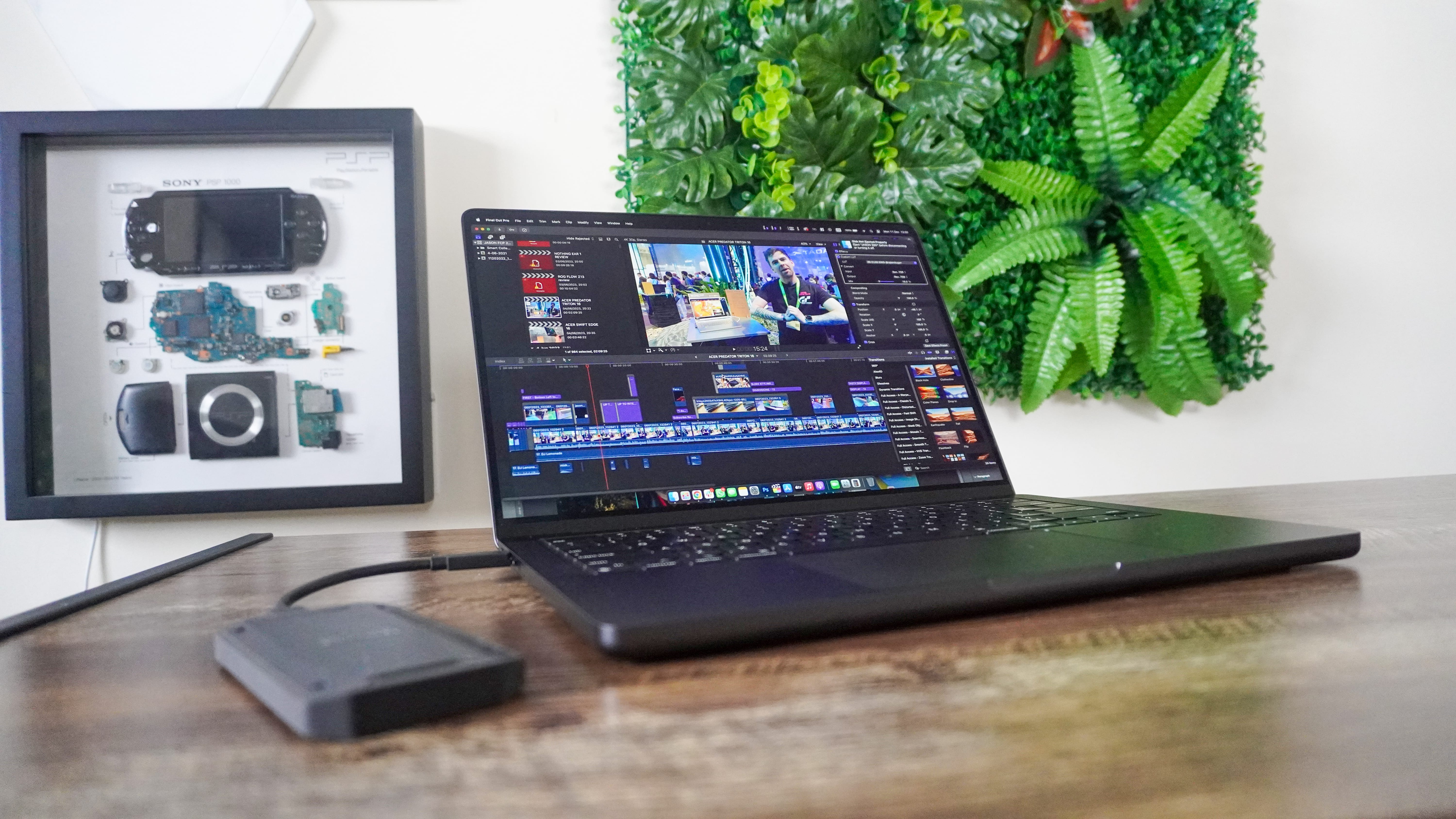
This is where things start to get a little interesting. Dissecting the machine will reveal its baseline M3 Pro chip with 11 CPU and 14 GPU cores, which is combined with 18GB RAM and a 512GB SSD. Other upgrades include an enhanced 16-core Neural Engine, an upgraded media engine that supports AV1 decoding, and of course that new 3nm process to stuff 37 billion transistors on its silicon.
But while there are some significant gains to be found when putting the standard M2 up against M3 (20% faster Geekbench 5 multi-core result) and M2 Max vs M3 Max (47% faster Geekbench 6 multi-core result), the differences are slimmer when it comes to stacking it up against the M2 Pro MacBook Pro.
| Laptop | Geekbench 6 single-core | Geekbench 6 multicore | Blackmagic Disk Speed write (MBps) | Blackmagic Disk Speed read (MBps) |
|---|---|---|---|---|
| MacBook Pro 14-inch (M3 Pro) | 3154 | 14357 | 4211.5 | 5069.6 |
| MacBook Pro 14-inch (M2 Pro) | 2673 | 12253 | 2932.1 | 3455.8 |
| MacBook Pro 14-inch (M3) | 3138 | 12018 | 2769.1 | 2904.3 |
| MacBook Pro 16-inch (M3 Max) | 3200 | 21711 | 7594.2 | 5561.1 |
While I’m glad they’ve sorted out the SSD speeds from chopping them in half for M2, this is a smaller improvement. In fact, the standard M3 is getting rather close to that M2 Pro power potential — with numbers that most users will not have a problem with whatsoever.
The real difference comes down to when you put that Media Engine and graphics to work, where you can see that the GPU of the M3 Pro starts to pull more of a lead over M3 and M2 Pro.
| Laptop | Handbrake time | Photoshop |
|---|---|---|
| MacBook Pro 14-inch (M3 Pro) | 04:34 | 1120 / 4:06 |
| MacBook Pro 14-inch (M2 Pro) | 05:03 | 934 / 4:40 |
| MacBook Pro 14-inch (M3) | 05:37 | 877 / 4:53 |
| MacBook Pro 16-inch (M3 Max) | 02:34 | 1443 / 3:29 |
So, on paper, Apple has done the deed. The M3 Pro continues to be the faster mid-range system of the MacBook Pro lineup, but you have to seriously ask yourself if those additional 47 seconds of time saved are worth $400 — even more so when you take a look at the savings on outgoing M2 Pro models and that 34-second difference.
M3 Pro MacBook Pro: Graphics and gaming
- Next generation GPU is rather subdued in M3 Pro
- Only small gains over standard M3 when it comes to gaming
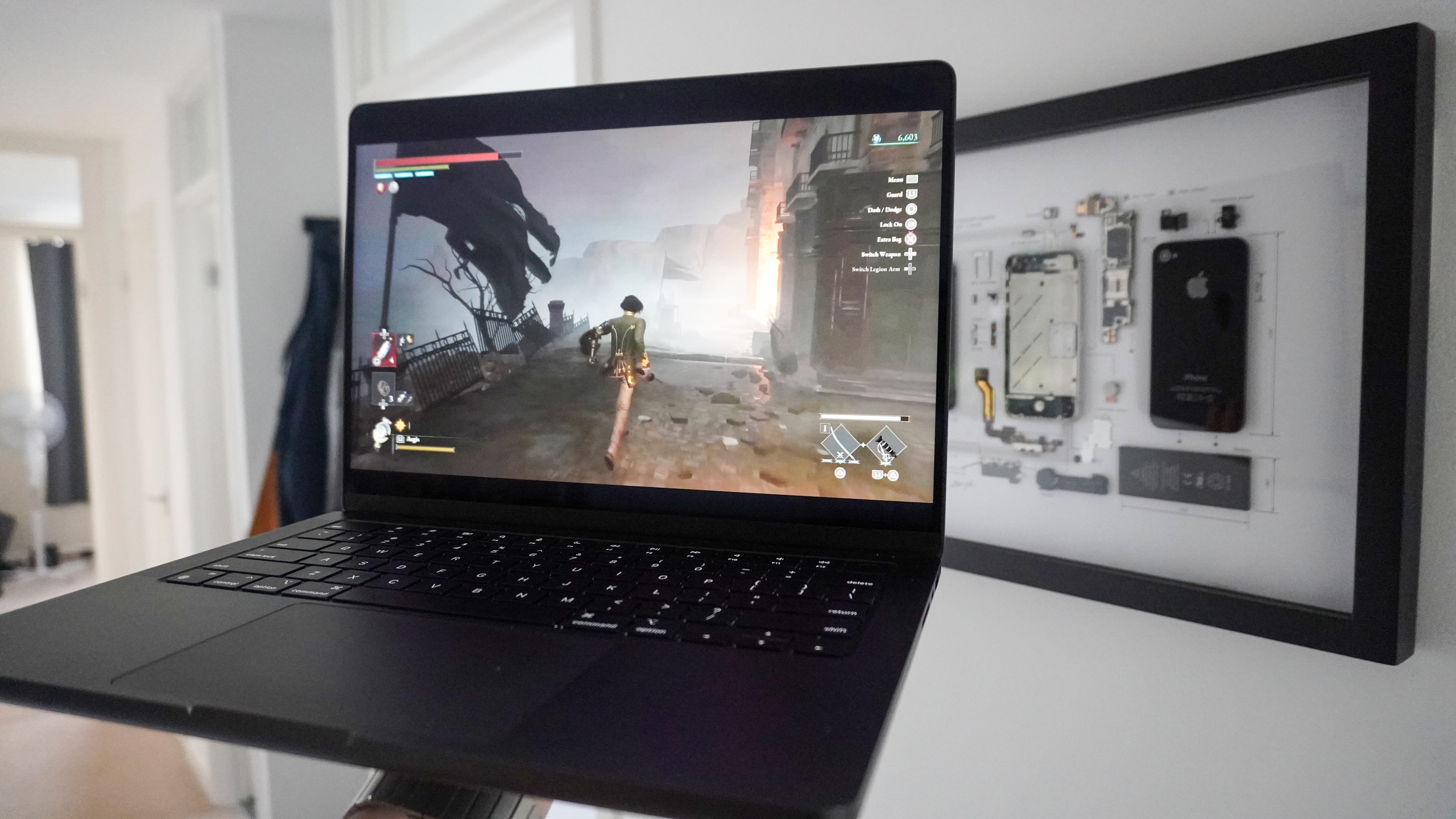
One place where all that could change is when looking at that new generation 14-core GPU. Eager-eyed observers of Tom’s Guide over the past year will see that is two less cores than what the M2 Pro MacBook Pro had.
However, with new technologies like dynamic caching making more efficient use of the GPU, and the same hardware-accelerated ray tracing support that the A17 Pro got in the iPhone 15 Pro and Pro Max, the M3 Pro does take a lead — but only a small one.
| Laptop | Wild Life (Extreme) | Wild Life (Unlimited) |
|---|---|---|
| MacBook Pro 14-inch (M3 Pro) | 11957 | 12055 |
| MacBook Pro 14-inch (M2 Pro) | 10554 | 11189 |
| MacBook Pro 14-inch (M3) | 7810 | 8259 |
| MacBook Pro 16-inch (M3 Max) | 14319 | 31271 |
Of course, it leaves M3 in the dust, and is itself demolished by the M3 Max, but the gap to M2 Pro is a narrow one. The same can be said in gaming framerate tests too.
| Gaming benchmark | Resolution | MacBook Pro 14-inch (M3 Pro) | MacBook Pro 14-inch (M2 Pro) | MacBook Pro 14-inch (M3) | MacBook Pro 16-inch (M3 Max) |
|---|---|---|---|---|---|
| Borderlands 3 | 1920 x 1200 | 28.9 fps | n/a | 19.8 fps | 54.6 fps |
| Sid Meier's Civilization VI | 1920 x 1200 | 53.7 fps | 56.8 fps | 50 fps | 59 fps |
| Shadow of the Tomb Raider | 1920 x 1200 | 48 fps | 43.2 fps | 33 fps | 118 fps |
More and more games will start to improve over time, as more developers start to take advantage of the Game Porting Toolkit and build a library of titles that play nice with Metal. But if these differences are relative to what we can expect, those small gains in framerate by going for M3 Pro over M3 aren’t necessarily worth the additional investment in my opinion.
M3 Pro MacBook Pro: Battery life and heat
- Lasts for 17 hours and 22 minutes
- Does not break a sweat at all
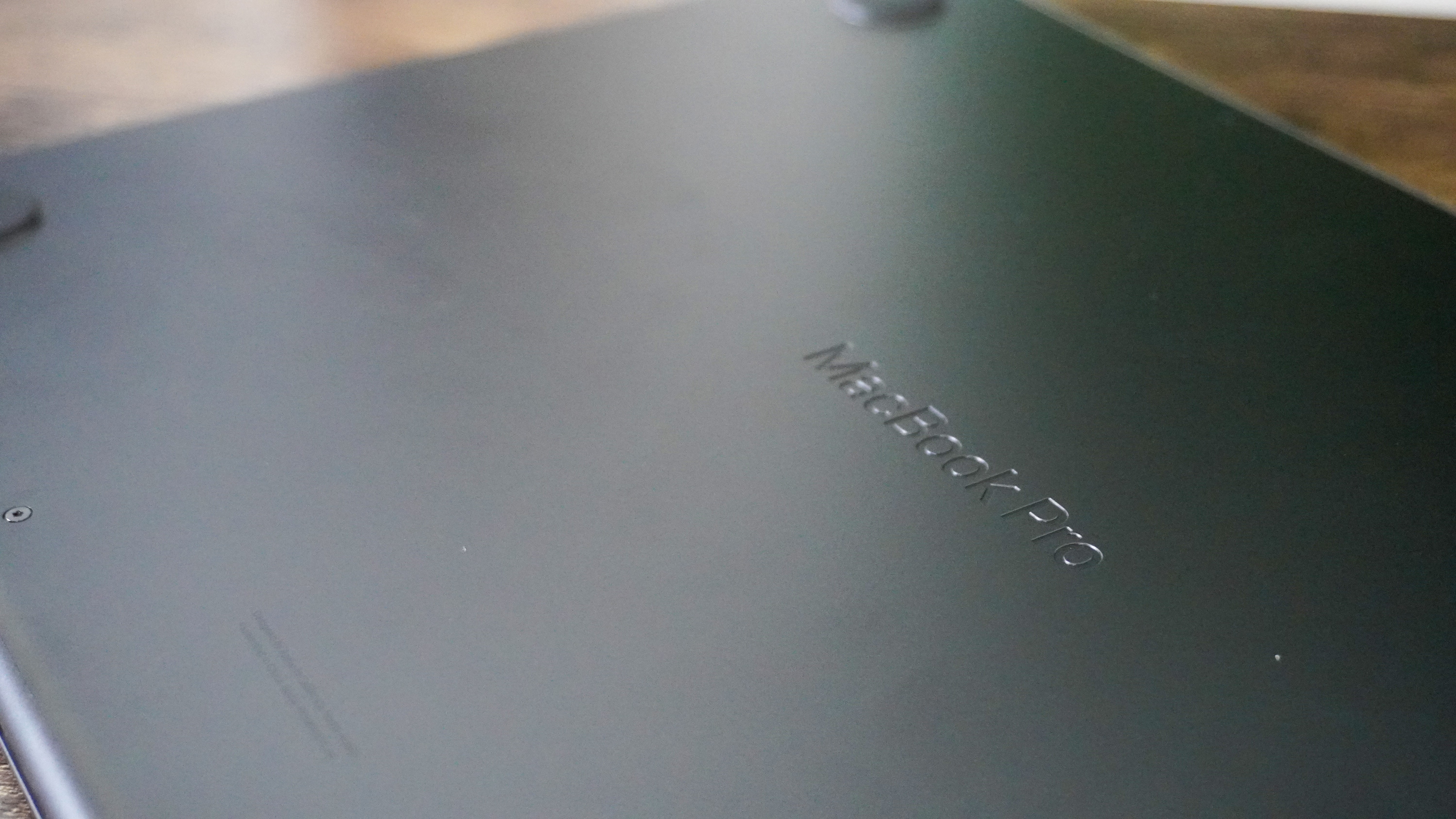
Apple silicon’s superpower has always been its thermal management and battery life. That is no different with the M3 Pro MacBook Pro, as it’s a stamina king that gains nearly an hour over its older M2 Pro brother.
| Laptop | Battery life (web surfing hh:mm) |
|---|---|
| MacBook Pro 14-inch (M3 Pro) | 17:22 |
| MacBook Pro 14-inch (M2 Pro) | 16:38 |
| MacBook Pro 14-inch (M3) | 17:25 |
| MacBook Pro 16-inch (M3 Max) | 17:11 |
This comes down to the configuration of cores — the M2 Pro has a higher proportion of performance cores, whereas the M3 Pro opts for more efficiency cores. This leads to it being the second longest-lasting MacBook Pro of the new generation (behind the standard M3 model).
Plus, on the temperature front, nothing troubles the thermal efficiency of this system, even under the intense pressure of our own lab testing.
| Laptop | Temperature (Touchpad) | Temperature (G/H keys) | Hottest surface & temperature |
|---|---|---|---|
| MacBook Pro 14-inch (M3 Pro) | 76.1 degrees | 79.5 degrees | 81.3 degrees (F7 key) |
| MacBook Pro 14-inch (M2 Pro) | 78 degrees | 80.5 degrees | 81.5 degrees (underside) |
| MacBook Pro 14-inch (M3) | 77 degrees | 78.5 degrees | 78.5 degrees (underside) |
| MacBook Pro 16-inch (M3 Max) | 75.5 degrees | 80.5 degrees | 81 degrees (underside) |
All of these fall well below the 95-degree threshold for a laptop being comfortable to use, so you’ve got nothing to worry about when it comes to a burning crotch!
M3 Pro MacBook Pro: Keyboard, touchpad and webcam
- Still one of the best keyboard and touchpad experiences on a laptop
- Nice clarity and color on the 1080p webcam
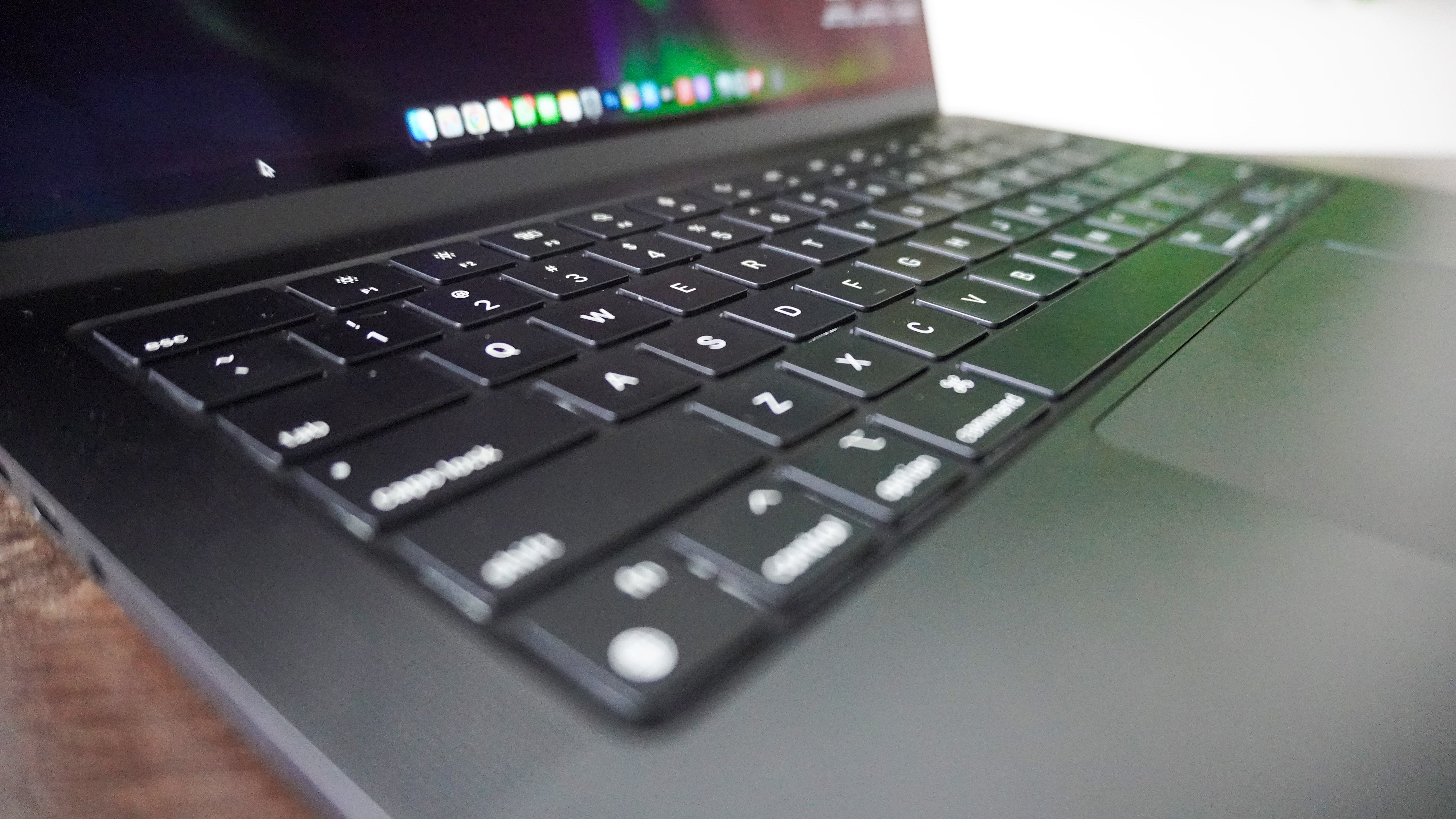
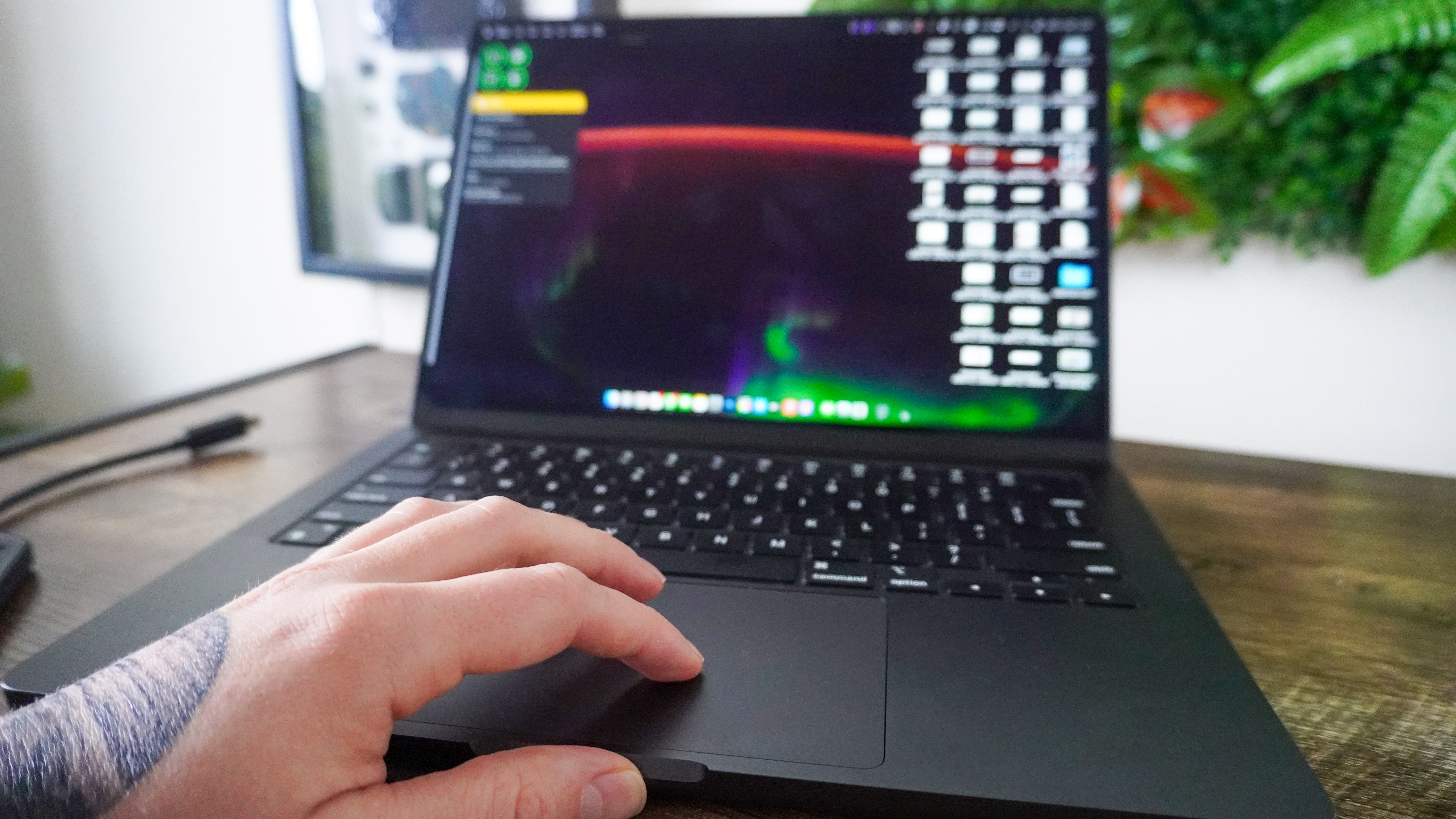
Another three things that remain untouched from previous generation MacBook Pros is its keyboard, touchpad and webcam. And much like a fine wine, they are aging just fine.
Your fingers fly across the spacious touchpad and clicks are responded to with an impressive haptic force that makes every interaction feel intentful. This is paired with a chiclet keyboard that is a joy to type on with its scissor switches and 1mm of key depth. Once you get the hang of the multi-touch gestures and keyboard shortcuts baked into macOS Sonoma, you will be flying through your work with the greatest of ease.

As for the 1080p FaceTime webcam, the image signal processor and Neural Engine combine to make for a nice picture quality that combines a nice sharpness with well-balanced color. Apple claims it's better than the M2 Pro, but I’m struggling to see any real difference, which is no terrible thing — given the picture is still up there as one of the best of any built-in laptop webcams.
M3 Pro MacBook Pro: Verdict
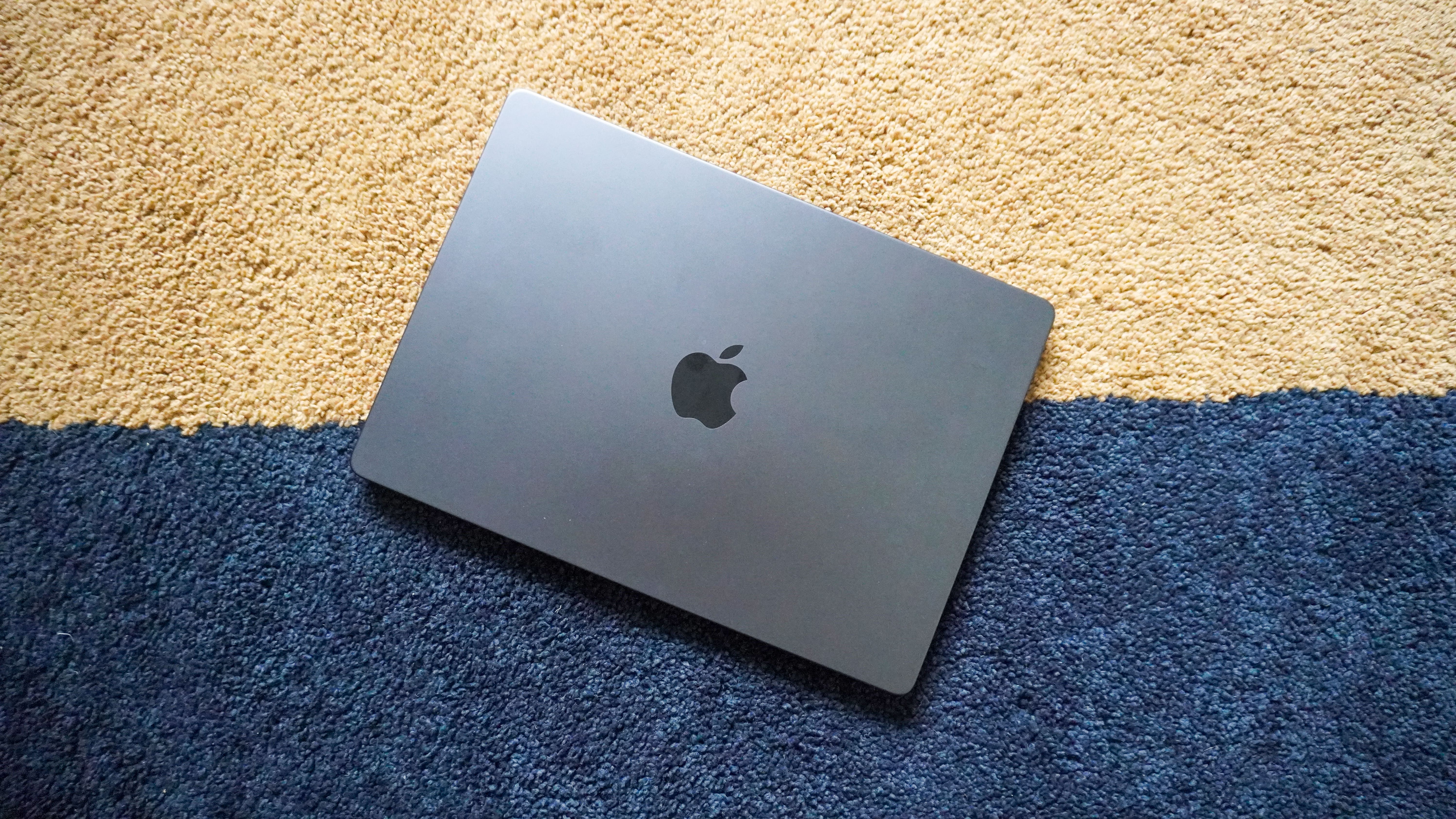
And that’s the tale of the M3 Pro MacBook Pro: a laptop that feels a bit lost in the mix.
For all intents and purposes, this is a great machine that continues to defy the logic set by even the best Windows laptops. Battery life continues to be great, even though M3 Pro absolutely slaps in power and graphical performance. The utilitarian aesthetic is made all the more badass with a Space Black finish, which is complemented by a typing and clicking experience that continues to be one of the best in the industry.
But who is this for exactly? The vast majority of what this machine is capable of can be done by the cheaper 14-inch Pro with M3, but only slightly slower. On the other end of the scale, if you did have a demanding creative workflow with tight deadlines, then leapfrogging the Pro in favor of M3 Max would be the way to go.
When the 13-inch Pro existed, this family tree made the 14-inch with a Pro-tier chip the easier choice. But if I were you and you’re looking at this mid-tier choice, ask yourself whether it’s the best investment of Apple’s prosumer laptop lineup. In the face of minor gains, I’m betting most of you will say “no.”

Jason brings a decade of tech and gaming journalism experience to his role as a Managing Editor of Computing at Tom's Guide. He has previously written for Laptop Mag, Tom's Hardware, Kotaku, Stuff and BBC Science Focus. In his spare time, you'll find Jason looking for good dogs to pet or thinking about eating pizza if he isn't already.
-
cameronbosch This review misses a critical point. It's not $400 between the M3 & M3 Pro MacBook Pros. It's $200 for a similar amount of RAM and storage.Reply
The biggest problem with the M3 MacBook Pro is that 8 GB of RAM on Apple Silicon is unified between the CPU & GPU and macOS takes around 4 - 5 GB at a cold boot as shown by Max Tech, one of the best known Apple reviewers on YouTube. So once you open around 5 or so Chrome tabs, the system already has to use swap SSD, which is not only slower and thus slows the entire system down, but also will wear the non replaceable SSD, and once it exhausts its read/write cycles, congratulations, you now own a brick.
Once you upgrade the M3 model to 16 GB, the minimum I would consider okay for not only the price in 2023 but also for a "Pro" laptop, you are now only $200 from a M3 Pro MacBook Pro with 18 GB of RAM, an extra Thunderbolt 4 port, actually usable external monitor support (two instead of just one), HDMI 2.1 instead of 2.0, and the better CPU & GPU performance of the M3 Pro. So in my opinion, spending $200 more (or just 10% more money) on the M3 Pro MacBook Pro actually is a no brainer for MacBook Pro shoppers. If you don't want to spend $2000, either get a refurbished M2 Pro MacBook Pro, which can often be had for the same $1600 price tag, or wait for the M3 MacBook Airs to come out, which will be cheaper and you can spend the difference to upgrade the RAM.
TL;DR, the MacBook Pro M3 is just an upselling strategy by Apple; don't buy it. -
Jian007 I think that the 14 inch M3 Pro MacBook Pro is a great value. It's not meant to be a compelling upgrade from the M2 Pro, or maybe even the M1 Pro for lots of people. It is a great MacBook to pick up if coming from any Intel based MacBook or Windows laptop, or if you're just now getting a MacBook Pro. The performance difference between the binned version and the unbinned version is only around 10% in most cases, and the unbinned version costs 25% more. Currently Best Buy is selling the binned 14 inch M3 Pro MacBook Pro for $1799, which is a great value for what you're getting, as that's only $100 more than the MSRP of a 15" MacBook Air with 16GB RAM and 512GB SSD, and you're getting a lot more features (and performance) for that money.Reply
So many reviewers continue to try and say the M3 Pro MacBook Pro is some kind of crappy MacBook, just because it doesn't blow the M2 Pro away like the M3 Max does to the M2 Max. People who really need ultimate performance and need the absolute fastest for their use case, are not even considering the M3 or M3 Pro and will be getting the Max anyways. But for the rest (and majority) of the users, the M3 Pro represents a decent value if shopping for a new MacBook Pro, as it will do many tasks very well, and not force you to pay much higher prices for the Max variants. But I agree with what cameronbosch said in the previous comment, and that's that the base model M3 MacBook Pro is really not a good value for anyone, and shouldn't have been released, other than a way to get users to upgrade to the M3 Pro or Max (which is good for Apple and sucks for the consumers). -
cameronbosch Reply
Yeah, not every laptop generation is going to offer 30% performance gains over a single generation; these "reviewers" need to step into the shoes of actual users; many of them know that CPU & GPU gains are usually smaller gen on gen, and while that's certainly the case here, that's just the facts. Also, most Apple consumers just looking for a MacBook will not notice a serious difference between the M2 MacBook Air, the upcoming M3 MacBook Air, the M3 MacBook Pro, and the M3 Pro MacBook Pro. You don't need 15% - 30% more performance just to surf the web and type up documents. What would be nice is more battery life, and that's what the M3 lineup brings with the die shrink.Jian007 said:But I agree with what cameronbosch said in the previous comment, and that's that the base model M3 MacBook Pro is really not a good value for anyone, and shouldn't have been released, other than a way to get users to upgrade to the M3 Pro or Max (which is good for Apple and sucks for the consumers).
Like we've said, the M3 MacBook Pro shouldn't exist. 8 GB of RAM in 2023 for $1600 is an embarrassment, and almost all users would be better off with 16 GB of RAM. But once you do so, you're only $200 (or 10%) from the far better M3 Pro MacBook Pro. Like you said, the M3 model is just a decoy meant to entice users to pay more for a usable system. Because 1 external display, 8 GB of RAM, and other compromises for $1600 are embarassing. If a Windows OEM tried to do this, they'd be dragged through the coals. But because it's Apple, it's okay? Nope, it's not. Reviewers need to keep calling out Apple for this type of behavior, especially when the M2 MacBook Air can be had on sale for less money with a 16 GB of RAM and 512 GB of storage upgrades, and it's honestly enough for most Apple consumers.
